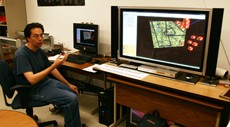War may be an unavoidable element of human life, but researchers in the department of electrical and computer engineering are working on a program that aims to do battle against the institution of war itself, and maybe make it as obsolete as floppy disks or last year’s iPod.
Jerzy Rozenblit, professor of electrical and computer engineering, and his team of graduate students are developing a computer program known as the Asymmetric Threat Response and Analysis Project, or ATRAP.
The software is used to construct 3-D models of places, people, and events over time in such a way that undesirable occurrences like armed conflict can be predicted and hopefully avoided.
“”Our purpose is to ask, ‘are we able to model certain behaviors, are we able to analyze data in a manner that allows us to be smart in terms of proposing a solution that might resolve a conflict to the extent that perhaps nobody wins, but it’s a kind of win-win for everybody,'”” Rozenblit said.
Rozenblit was recently awarded a $2 million grant from the U.S. Army for the project, and he estimates the total cost of the project to be around $8 million.
Onscreen, the program appears as a map similar to what you see when you use Google Earth. Appearing to float above the map are a number of small cubes, each representing an event. The closer the cubes are to the map, the more recently they occurred.
The goal of the software is to take a huge database of these events, work out the relationships between them, look for patterns, and use that information to make predictions about future events, Rozenblit said.
Getting the databases is easy, he said, because “”tremendous”” volumes of data already exist. The hard part is programming the computer to recognize patterns and extrapolate them into the future.
“”Had we been able to understand better what the patterns of behavior are,”” Rozenblit said of the Kosovo War in the late 1990’s, “”perhaps we could introduce some courses of action that enlighten leaders in a manner that doesn’t make it profitable to actually behave in this particular way.””
Because information about behavior and relationships is considered “”soft,”” Rozenblit said, the team has been working with faculty from the political science department and the Eller College of Management to draw conclusions about these factors.
Being able to model and predict patterns of behavior is a useful tool even beyond the combat zone, Rozenblit said. He cited the recent financial crisis and natural disasters such as Hurricane Katrina as situations where such modeling may have been extremely useful.
“”The big thing that is unique about this application is its predictive capabilities,”” said Brian Ten Eyck, a research support director for electrical and computer engineering. “”It’s not just a historical analysis of things that happened, but it’s in fact suggesting what may happen based on information that (exists) in the database.””
Rozenblit seconded that opinion.
“”Usually we are very reactive,”” he said. “”This is a tool that would allow us to be proactive. That’s the bottom line.””









